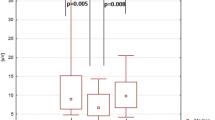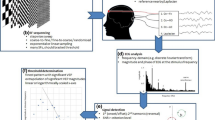Summary
In view of the fact that with psychophysical methods monocular luminance changes may increase the detection rate of pathological interocularlatency differences in MS patients, we studied the influence of stimulus luminance on the detection rate of MS using checkerboard visual evoked potentials. Decrements of stimulus luminance covering a range of three log units were unable to increase the detection rate of VEP. Regression coefficients of the luminance-latency functions did not differ in MS patients and normals. Contrary to the hypothesis tested, the diagnostic significance of VEP decreases with decreasing stimulus intensity.
Zusammenfassung
Nachdem psychophysische Experimente nahelegen, daß schon nach geringen Leuchtdichteänderungen die interokulären Latenzdifferenzen bei MS-Patienten beträchtlich zunehmen, untersuchten wir den Einfluß von Leuchtdichteänderungen auf die diagnostische Trefferrate der VEP bei der Multiplen Sklerose. Über einen Bereich von drei logarithmischen Einheiten brachten Leuchtdichteänderungen keine Zunahme der diagnostischen Ausbeute. Auch die Regressionskoeffizienten der Funktion VEP-Latenz gegen Leuchtdichte unterschieden sich bei MS-Kranken nicht von denen bei Gesunden. Da bei abnehmender Leuchtdichte die Trefferquote der VEP sogar deutlich abnimmt, muß diese Variable in der Klinik beachtet werden.
Similar content being viewed by others
References
Asselmann P, Chadwick DW, Marsden CD (1975) Visual evoked responses in the diagnosis and management of patients suspected of multiple sclerosis. Brain 98:261–282
Cant BR, Hume AL, Shaw NA (1978) Effects of luminance on the pattern visual evoked potential in multiple sclerosis. Electroencephalogr Clin Neurophysiol 45:496–504
Diener HC, Scheibler H (1980) Follow-up studies of visual potentials in multiple sclerosis evoked by checkerboard and foveal stimulation. Electroencephalogr Clin Neurophysiol 49:490–496
Halliday AM, McDonald WI, Mushin J (1972) Delayed visual evoked response in optic neuritis. Lancet 1:982–985
Halliday AM, McDonald WI, Mushin J (1973) Visual evoked responses in diagnosis of multiple sclerosis. Br Med J 4:661–664
Hennerici M, Wenzel D, Freund HJ (1977) The comparison of small-size rectangle and checkerboard stimulation for the evaluation of delayed visual evoked responses in patients suspected of multiple sclerosis. Brain 100:119–136
Hennerici M, Wist E (1981) A modification of the VER method for the diagnosis of demyelinating diseases involving small luminance decrements. Proc Int Symposium: Clinical application of evoked potentials in neurology. Lyon (Abstract)
Kjaer M (1980) Visual evoked potentials in normal subjects and patients with multiple sclerosis. Acta Neurol Scand 62:1–13
Kjaer M (1981) The value of sequential EP recordings in MS patients. Proc Int Symposium: Clinical applications of evoked potentials in neurology. Lyon (in press)
Lowitzsch K, Kuhnt U, Sakmann C, Maurer K, Hopf HC, Schott D (1976) Visual pattern evoked responses and blink reflexes in assessment of MS diagnosis. J Neurol 213:17–32
Matthews WB, Small DG, Small M, Pountney E (1977) Pattern reversal evoked visual potential in the diagnosis of multiple sclerosis. J Neurol Neurosurg Psychiatr 40:1009–1014
McAlpine D, Lumsden CE, Acheson ED (1972) Multiple sclerosis. A reappraisal. Churchill Livingstone, Edinburgh
Oepen G, Brauner C, Doerr M, Thoden U (1981) Visual evoked potentials (VEP) elicited by checkerboard versus foveal stimulation in multiple sclerosis. Arch Psychiatr Nervenkr 229:305–313
Tackmann W, Strenge H, Barth R, Sojka-Raytscheff A (1980) Diagnostic validity for different components of pattern shift visual evoked potentials in multiple sclerosis. Eur Neurol 18:234–248
Trojaborg W, Petersen E (1979) Visual and somatosensory evoked cortical potentials in multiple sclerosis. J Neurol Neurosurg Psychiatr 42:323–330
Wist ER, Hennerici M, Dichgans J (1978) The Pulfrich spatial frequency phenomenon: a psychophysical method competitive to visual evoked potentials in the diagnosis of multiple sclerosis. J Neurol Neurosurg Psychiatr 41:1069–1077
Author information
Authors and Affiliations
Rights and permissions
About this article
Cite this article
Diener, H.C., Koch, W. & Dichgans, J. The significance of luminance on visual evoked potentials in diagnosis of MS. Arch Psychiatr Nervenkr 231, 149–154 (1982). https://doi.org/10.1007/BF00343836
Received:
Issue Date:
DOI: https://doi.org/10.1007/BF00343836




